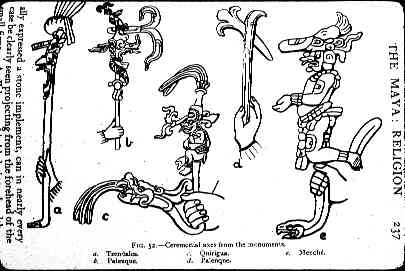

The simplist is in figure (d) above, a hand-held staff with a stylized axe head attached. A more complex variant is in (a), as in the following example of the Ceremonial Staff on an 8-foot-high carving on Stela 5 at in the Mayan site of Piedras Negras:
In some instances, the axe head itself was a symbol of a serpent's head and mouth, as shown even more stylized in (b) (also compare with the same serpent-head structures found in the Ceremonial Bar).
In some Ceremonial Staffs, as in (a) and (e), the staff portion elongated into a serpent's body. The serpent, of course, was an immensely powerful symbol in ancient Meso-American cultures -- particularly the symbol of the feathered serpent, such as the enormous number of carvings of the feathered-serpent god Quetzlcoatl that adorns many structures at Teotihuacan outside Mexico City.
Eventually, the Ceremonial Axe became stylized into the miniature body of a Mayan deity, as shown in (b), (c), and (e). These became the Manikin Scepter, symbol of god-power.
Thus, perhaps a sequence of how these symbols evolved might be something
like this:
- a simple staff or pole
- a staff symbolizing and conjuring the power of
a serpent
- a serpent-staff adorned with an axe head
- the axe-head symbolized by a serpent's head
- the axe-head serpent's head gaping
- the axe-head serpent's head gaping with the power
of a god-image emerging
- the axe-head symbolized by the god-image itself
- the entire Ceremonial Staff represented by a Manikin
Scepter
Back to the Ancient America Page
Back to The Knowledge Plexus